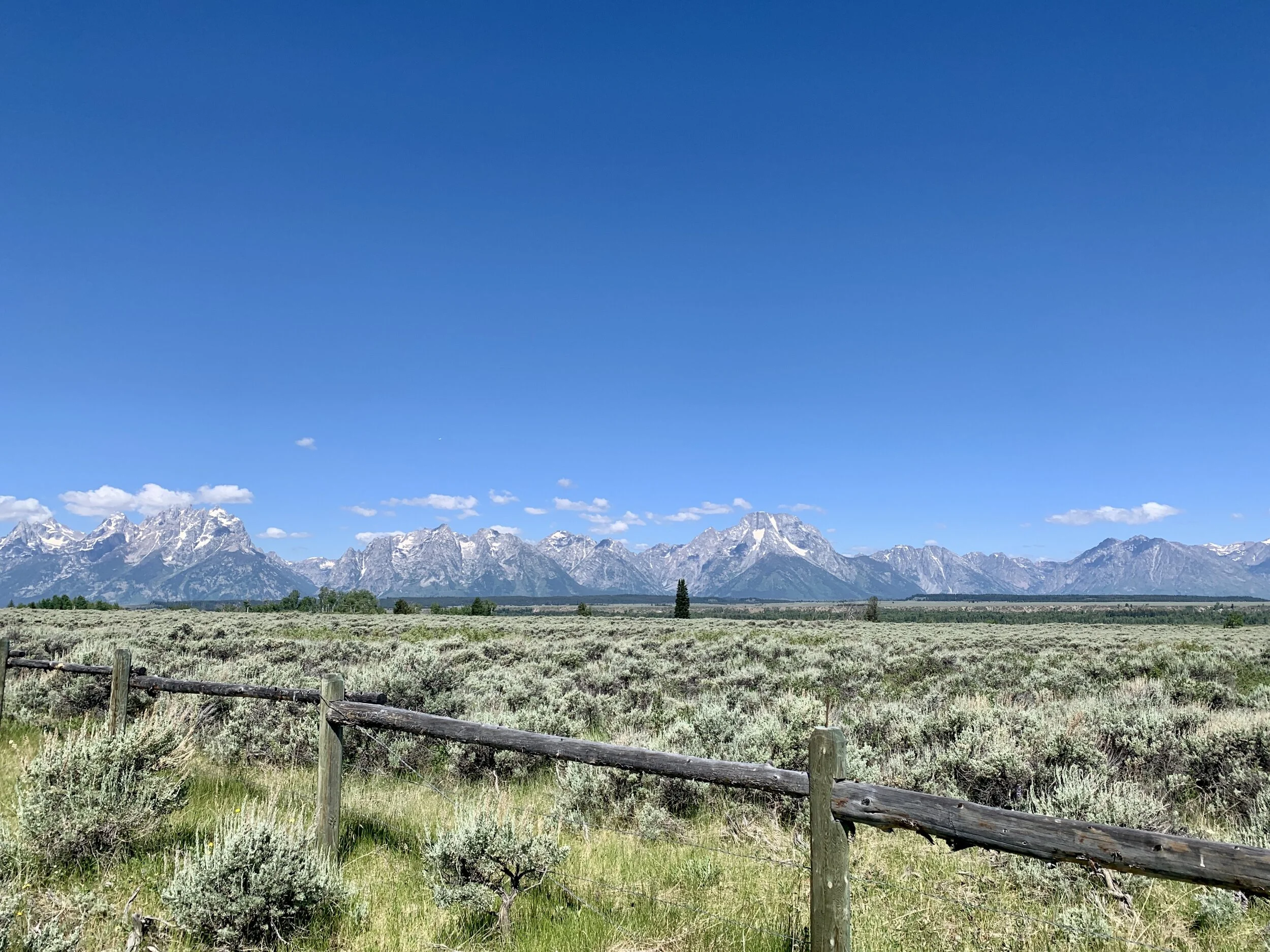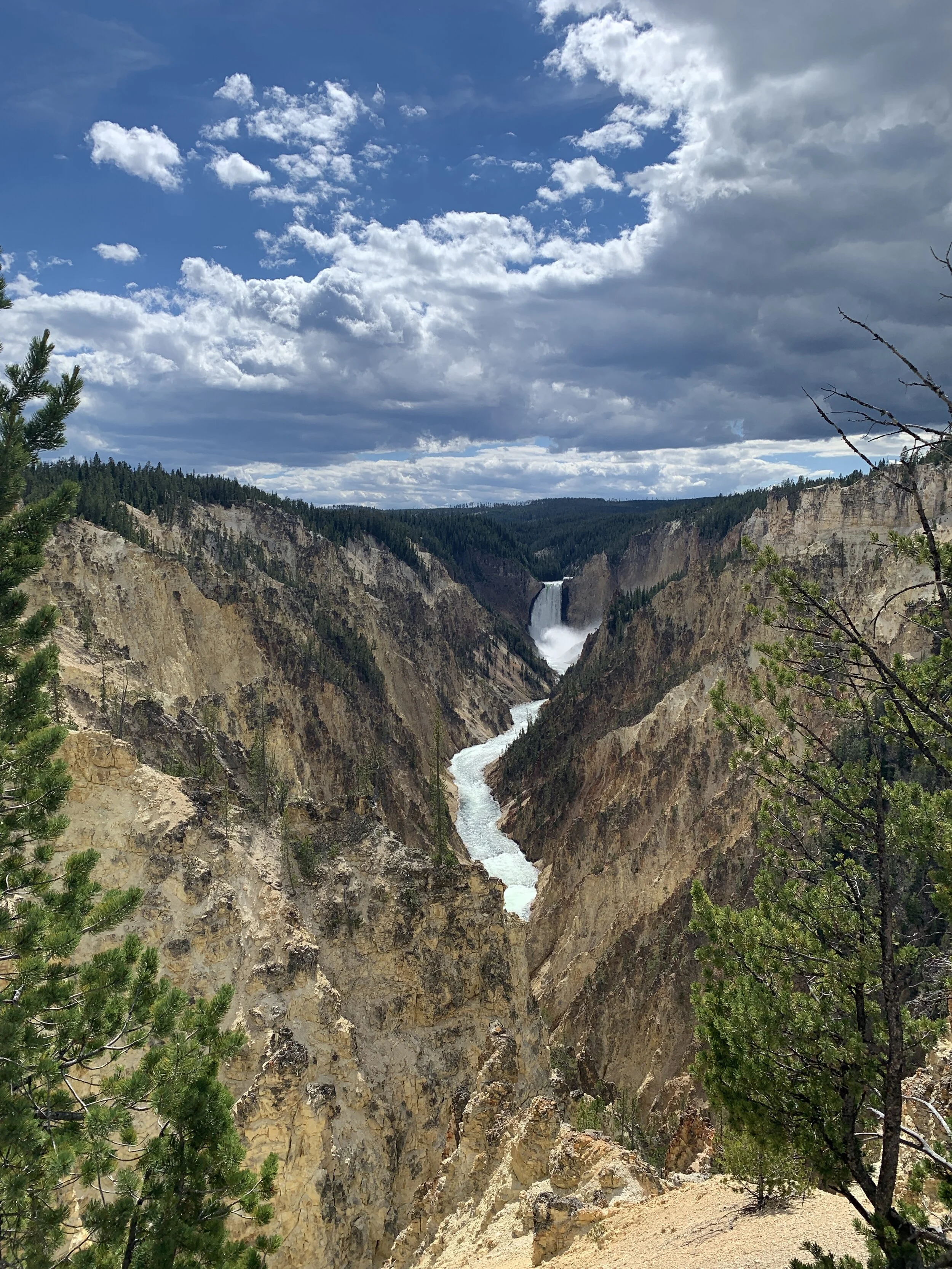From planning to implementation
I bought my first can of bear deterrent at a local outdoor store. The trail I chose to hike near Yellowstone had a 3-week old review that mentioned a grizzly bear sighting. Additionally, I kept Sadie on the leash. Hiking in the Rockies provides unfamiliar dangers: rattle snakes, large bears, lack of water, and moose (which I’m most scared of—a Moose is more likely to charge you than a bear attack you, from what I’ve gathered. Especially if a calf is present). During a hike in Cache National Forest a mountain biker rounded the corner in front of me and stopped.
“There is a moose and her calf up ahead. They were on the trail and I had to get them off. They might charge you, but they seem to be heading away so you’re probably fine.” he said.
“Cool, thanks. Good to know.” I said smiling.
He rode on. I stood frozen for a moment, unsure of what I would do if I encountered this moose and her baby. Sadie and I eventually walked on, slowly. My eyes scanned the scrubby forest.
I always feel comfortable in the mountains, and none of those threats dissuade me from hiking, but I have been more on-alert during my hikes in the Rockies.
There is a more extreme danger that has haunted me the past few weeks: climate change. While disrespectful park visitors make me want to yell, and moose may cause my heartbeat to increase, the effects of climate change in the national parks have brought me to tears on this trip.
My national park tour was the focus of a proposal I submitted to the University of New Hampshire for funding during the summer when I am no longer paid for my teaching responsibilities. The writing project was centered around the belief and disbelief of global climate change. I had hoped to talk with National Park employees and park visitors about their perceptions of the issue. Primarily I am curious about the generational differences in opinion on this topic: older generations tend to devalue the urgency of climate change action, while younger generations see it as a major issue (Pew Research: here & here). I wanted the national park lands to be a literal common ground for this potentially contentious issue: even if people disagree, they all have chosen to come to a national park. They all attribute some value to protecting nature-spaces.
The proposal was not chosen, and I’m income-less this summer, but I chose to see the parks regardless. My proposal included a working bibliography of 30 research articles and environmental advocacy organization resources that I catalogued on my computer. A week ago I opened the folder and began reading.
The article, or report rather, that I opened was published by the Union of Concerned Scientists. Each chapter is dedicated to a particular thread: an increase in tree-killing insects, increase in wildfires, the impacts of heat and dryness on forests, and the effects on iconic tree species of the Rocky Mountains.
Chapter six is titled, Present and Future Climate Change in the Rocky Mountains. The chapter opens bluntly (p.38):
Temperatures have risen more in the Rocky Mountain region than in the nation as a whole over the past 20 years.
Exceptional heat and dryness from 1999-2003 triggered major impacts on forests.
Projections show that temperatures will continue to rise, even with significant cuts in heat-trapping emissions. If emissions remain unchecked, temperatures could rise twice as fast.
I was reminded of an exhibit sign I saw at the Alpine Visitor Center in RMNP. The sign showed a picture of a white-tailed Ptarmigan. The bird is uniquely adapted to the snowy peaks of the Rockies (it even has feathers in its nose the sign exclaims!). Unfortunately due to earlier snow melt, and increased temperatures, the bird’s food and reproductive cycles are threatened. Additionally, the plants that feed these birds—and other animals such as elk, and marmots— have timed their seed releases based on seasonal snowfall and melt. Plant cycles have also been interrupted.
Earlier snowmelt, or later affect stream flow. Both are recorded up to 30 days by the Union of Concerned Scientists in the Rocky Mountain region. If snow melt occurs earlier, then stream flow higher earlier in the season, which means there is less water later in the summer when it is needed most. A drier summer means a dry forest. This results in a higher risk of wildfires, and when wildfires do occur, they cover more area and do more damage.
The temperature in the Rockies delicately balances the release of water through snowmelt. Any change threatens regional species, including humans. In another piece of research (Halofsky et al.) the effects of snowmelt changes are studied in respect to “ecosystem services” of the region: Grazing (cattle ranchers), industrial wood (logging companies, recreation (skiing, camping, hiking. In 2001 visitors to the Yellowstone/Glacier park area spent about $800 million (Halofsky, 341)), and water protection (quantity and quality of water for residents). For all of the listed services, early snow melt, or reduced snow melt—due to reduced winter precipitation, which is due to (getting a pattern here?) increased temperatures—causes detrimental effects.
The researchers summarized it best:
“Climate change will likely result in increased occurrence of fire, insect outbreaks, and drought in the Rocky Mountains, driving ecosystem change and making the future provisioning of ecosystem services uncertain. Climate change will affect water availability and quality, human behavior and recreation, and provisioning of timber and forage. Decreased quantity and quality of ecosystem services produced by public lands will affect human systems that rely on them, requiring communities to seek alternative means of providing these services or to change local economies and lifeways” (341).
This is a broad generalization, but as I’ve driven around rural Colorado and Wyoming, I don’t get the sense that citizens are huge supporters of “climate change” or “green” political candidates. I wonder how many cattle ranchers realize that their entire livelihood—and survival when it comes to accessing drinkable water—is dependent on combatting climate change? No amount of “protecting American jobs” will save cattle from a drought, or prevent a wildfire from destroying a ranch. Most of the jobs in the region depend on the amount of snowfall and snowmelt timing in the Rocky Mountains.
More intimately, I read the future projections outlined in these articles and thought of my own life. By the 2080s the Rocky Mountain “median flow date” [of snowmelt] will be 20 days earlier and the summer flows will decline by 20-40% (Halofsky, 351). I will be 91 years old. Will I have a partner? children? grandchildren? What will I have to watch happen to the earth? What will I worry about for my friends, my family, for young people with their lives ahead of them? Yes, I will be nearing the end of my life when this particular statistic comes to be, but these changes will be gradual and I will be there for the unraveling.
I hear you optimists out there, “IF it comes to be, Elise!” Yes, those numbers may not be reached by 2080. That can be argued. But what cannot be argued is that the near future, my future, will involve extreme environmental stresses. These predictions are scientific hypotheses, and there is the potential for slowing the predictions. But, a scientific prediction of this nature means that the process has already begun. It is happening. Perhaps by 2080 the median flow date might be only 10 days earlier instead of 20, that would be a victory, but this is already happening. It’s not an either-or situation: Either in 2080 snowmelt flow dates will either stay the same as they are today or be 20 days earlier. The situation is: what do we have to do to slow this process? And if you’re incredibly optimistic: can we reverse this and have flow dates from 100 years ago?
This sounds hopeless. I don’t mean it to be. But hope is what you have when you don’t have confidence. Hope is the thing that is leftover when you no longer know, in any way, what will become of you, or a situation. I have hope, but I do not have confidence.
I cried as I drove into Yellowstone National Park. The research is unwavering: things are changing and it does not look good. Each article I’ve mentioned provides a list of strategies and tactics for dealing with these changes. The “What We Can Do” chapter from the Union of Concerned Scientists is uplifting. Yes, there are things we can do. But what affected me the most, what caused me to react so emotionally, was the final line in the article “Understanding and Managing the Effects of Climate Change on Ecosystem Services in the Rocky Mountains” (Halofsky et al.):
“Federal agencies are now transitioning from the planning phase of climate change adaptation to implementation, which will ensure that ecosystem services will continue to be provided from federal lands in a changing climate” (351).
The National Forest Service and the Park Service are no longer in prep mode. They are taking action; not action to prevent, actions to manage and adapt. There is such a finality to that: climate change is happening, right now. I knew this to be the case, but the word ‘implementation' cemented what will be. The agencies in charge of protecting public lands are past the point of hoping that negative environmental change won’t happen; they are actively ushering our lands into a new, dangerous climate.
•
Works Cited
Funk, Jason, et al. Rocky Mountain Forests at Risk: Confronting Climate-Driven Impacts from Insects, Wildfires, Heat, and Drought, Ch. 6: Present and Future Climate Change in the Rocky Mountains, Union of Concerned Scientists, 2014, www.jstor.org/stable/resrep00032.2.
Halofsky, Jessica E., et al. “Understanding and Managing the Effects of Climate Change on Ecosystem Services in the Rocky Mountains.” Mountain Research and Development, vol. 37, no. 3, 2017, pp. 340–352. JSTOR, www.jstor.org/stable/90013241.



